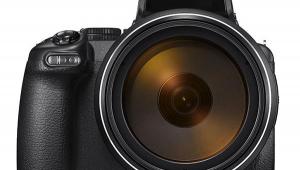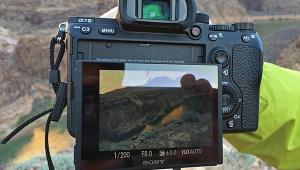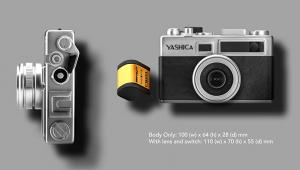Otto Barnack was/is not the ONLY corruption! Apparently the Americans didn't like the Germans/Germany very much. So, out is OTTO; and the same happend with the "DIN" setting. Afterall, it was the Deutsche Industrie Norm (and later 'Deutsches Institut für Normung') but then the ASA was already there ; NO GOOD, we [the Americans] made it ASA, and then ISO.
And the 'B' one can find on cameras is NOT BULP!! Also stolen from Deutschland, it was 'BLENDE'!!
Thank you Jon Sienkiewicz for an article in clear language and well written [and without needing a dictionary]!
Rethinking Auto. Is Using Auto ISO a Bad Thing?
I used to believe that the Auto setting on a camera was something to be avoided the way a tired waitress avoids eye contact when you’re signaling for a coffee refill—she can’t deny that you’re there, but she can ignore the hell out of you. I still feel that way about fully auto exposure, but my maniacally stubborn attitude toward Auto ISO is softening like marshmallow Peeps in a microwave.
Where Auto Got Its Name
Contrary to popular belief, “Auto” is not short for “Automatic.” “Auto” is the corrupted translation of “Otto,” the first name of Otto Barnack, the smarter older brother of Oskar Barnack, inventor of the first Leica and arguably the father of 35mm photography. Why you didn’t know this is beyond me.
Why I Used to Badmouth Auto ISO and Sometimes Still Do
Not so long ago, using a high ISO meant unavoidable noise and loss of image fidelity. In many cases, images shot at an ISO even as moderate as ISO 400 resembled bad pointillism. (Note that this is still true of some lower priced compact digital cameras, so don’t let me paint with too broad of a brush here.)
With those older cameras, and even with many of today’s low-end models, setting the ISO dial to Auto means risking that your images could look like the colors had been dripped through a screen door.
My prejudice is a carryover from shooting film, too, I’m sure. Panatomic-X had fine grain but a very low ASA of 32. Tri-X, at ASA 400, was fast but grainy. Kodachrome was fantastic but hobbled by an ultra-low ASA of 25. We learned that high ASA meant better low light capability at the expense of increased grain and less detail.
Incidentally, in case you’re wondering, ASA, the abbreviation for American Standards Association, was dropped in favor of ISO, short for International Organization for Standardization. Wait a minute—that’s IOS, no?
No. According to the ISO.org website, “Because 'International Organization for Standardization' would have different acronyms in different languages (IOS in English, OIN in French for Organisation internationale de normalisation), our founders decided to give it the short form ISO. ISO is derived from the Greek isos, meaning equal. Whatever the country, whatever the language, we are always ISO.”
Whatever indeed.
How Auto ISO Became Cool
Two things had to happen, and both did. First, technological advancements in image sensors and in-camera image processing engines (including noise reduction algorithms) improved so that shots taken at ISO 1600 and ISO 3200 are very good. Second, the Auto ISO setting on many cameras features High and Low limits so the user can set a default ISO as well as the upper ceiling. Some even allow a maximum slow shutter speed threshold as part of the ISO setting so that there’s no need to "worry about blurry."
This means I can dial in ISO 3200 as the max, ISO 200 as the default and 1/60 sec as the slowest shutter speed and be confident that my camera is shooting at a low ISO when possible and increasing the gain only when necessary.
A New Manual Auto Mode Has Been Born
I’m an advocate of Aperture Priority and Shutter Priority modes, and no stranger to Program Mode. Here’s a new twist: ISO Mode. Here’s how it works. I can set my Nikon Df on Manual Mode and Auto ISO. In average room light with a classic 35mm f2 Nikkor Ai-s lens I can set a shutter speed of 1/60 sec and an aperture of f/2.8. ISO fluctuates from around 320 to 640—a very safe range—while the shutter speed and aperture remain as set. I’m happy with the results because I know that this lens kicks butt at f/2.8 and I know I can easily handhold this outfit at 1/60 sec without camera shake. But more importantly I know that the quality—including noise level—at ISO 640 out of my Nikon Df is truly awesome.
Conclusion
Using Auto ISO is not like wearing a sign that reads, “Clueless Amateur.” Auto ISO can be cool, too. Maybe it has been all along; was it just my 15 Watt brain that prevented me from realizing it? Well, no. Actually, if I set my old Canon G5 on ISO 400 and shoot in modest light I get what I fondly call the Aquarium Gravel Effect: grain large enough to gag a guppy. So I’ll cut myself some slack and expound that technology has finally caught up with the feature and Auto ISO is finally a viable option—on some cameras, at least.
—Jon Sienkiewicz
- Log in or register to post comments

















































